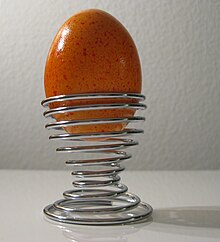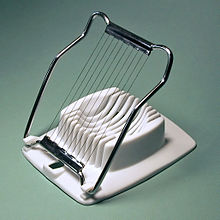Boiled egg



Boiled eggs are eggs (typically chickens' eggs) cooked by immersion in boiling water with their shells unbroken. (Eggs cooked in water without their shells are known as poached eggs, while eggs cooked below the boiling temperature, either with or without the shell, are known as coddled eggs.) Hard-boiled eggs are either boiled long enough for the egg white and then the egg yolk to solidify, or they are left in hot water to cool down, which will gradually solidify them, while a soft-boiled egg yolk, and sometimes even the white, remains at least partially liquid.
The egg timer was so-named due to its common usage in timing the boiling of eggs. Boiled eggs are a popular breakfast food in many countries around the world.
Variations
There are variations both in desired doneness and in the method of how eggs are boiled, and a variety of kitchen gadgets for eggs exist. These variations include:
- starting temperature
- Room temperature (for more even cooking and to prevent cracking) or from a refrigerator; eggs may be left out overnight to come to room temperature, comparable to how it is advisable to bring meat to room temperature before roasting.
- preparation
- Some pierce the eggs beforehand with an egg piercer to prevent cracking. There is much debate on this subject. Ekelund et al. in Why eggs should not be pierced claimed that pricking caused egg white proteins to be damaged and was therefore to be discouraged. Others recommend against this,[note 1] or add vinegar to the water (as is sometimes done with poached eggs) to prevent the white from billowing in case of cracking. For this purpose, table salt can also be used.
- placing in water
- There are various ways to place the eggs in the boiling water and removing: one may place the eggs in the pan prior to heating, lower them in on a spoon, or use a specialized cradle to lower them in. A cradle is also advocated as reducing cracking, since the eggs do not then roll around loose. To remove, one may allow the water to cool, pour off the boiling water, or remove the cradle.
- Steaming
- Eggs are taken straight from the refrigerator and placed in the steamer at full steam. The eggs will not crack due to sudden change in temperatures. At full steam, "soft-boiled" eggs are ready in 6 minutes, "hard-boiled" eggs at 8 minutes. As the eggs are cooked by a steam source, there is no variation of water temperature and hence cooking time, no matter how many eggs are placed in the steamer.
- cooking time
- There is substantial variation, with cooking time being the primary variable affecting doneness (soft-boiled vs. hard-boiled). It usually varies from 15–17 minutes for large hard-boiled eggs and 1–4 minutes for large soft-cooked eggs. Depending on altitude above sea level and humidity densities in a given climate, one may require extended amounts of time to reach the soft-boiled stage, and in fact, may never reach a fully hard stage.
- cooking temperature
- In addition to cooking at a rolling boil (at 100 °C), one may instead add the egg before a boil is reached, remove water from heat after a boil is reached, or attempt to maintain a temperature below boiling, the latter all variants of coddling.
- cooling
- After eggs are removed from heat, some cooking continues to occur, particularly of the yolk, due to residual heat, a phenomenon called carry over cooking, also seen in roast meat. For this reason some allow eggs to cool in air or plunge them into cold water as the final stage of preparation.
- service
- Boiled eggs may be served loose, in an eggcup, in an indentation in a plate (particularly a presentation platter of deviled eggs), cut with a knife widthwise, cut lengthwise, cut with a knife or tapped open with a spoon at either end, or peeled (and optionally sliced, particularly if hard-boiled, either manually or with an egg slicer).
Boiled eggs

Soft-boiled eggs are not recommended for people who may be susceptible to salmonella, such as very young children, the elderly, and those with weakened immune systems.[1]
Serving
Soft-boiled eggs are commonly served in egg cups, where the top of the egg is cut off with a knife, spoon or egg scissors, using a teaspoon to scoop the egg out. Other methods include breaking the eggshell by tapping gently around the top of the shell with a spoon.[2] Soft-boiled eggs can be eaten with buttered toast cut into strips, which are then dipped into the runny yolk. In the United Kingdom, these strips of toast are known as "soldiers".[3]
In Southeast Asia, especially countries like Malaysia, Singapore and the Philippines, soft-boiled eggs are also known as half-boiled eggs and are commonly eaten at breakfast. The major difference is that, instead of the egg being served in an egg cup, it is cracked into a bowl to which dark or light soy sauce and/or pepper are added. This variation is usually eaten with Kaya toast.
In Japan, soft-boiled eggs are commonly served alongside ramen. The eggs are typically steeped in a mixture of soy sauce, mirin, and water after being boiled and peeled. This provides the egg a brownish color that would otherwise be absent from boiling and peeling the eggs alone. Once the eggs have finished steeping, they are served either in the soup or on the side.
Hard-boiled eggs


Hard-boiled eggs are boiled for longer than soft-boiled eggs, long enough for the yolk to solidify.[4] They can be eaten warm or cold. Hard-boiled eggs are the basis for many dishes, such as egg salad, Cobb salad and Scotch eggs, and may be further prepared as deviled eggs.
Hard-boiled eggs are commonly sliced, particularly for use in sandwiches. For this purpose specialized egg slicers exist, to ease slicing and yield even slices.
There are several theories as to the proper technique of hard-boiling an egg. One method is to bring water to a boil and cook for eight to ten minutes.[5] Another method is to bring the water to a boil, but then remove the pan from the heat and allow eggs to cook in the gradually cooling water.[4][6] Others prescribe cooking in continually boiling water over heat for a shorter period of time.[citation needed]
Over-cooking eggs will typically result in a thin green iron(II) sulfide coating on the yolk.[7] This reaction occurs more rapidly in older eggs as the whites are more alkaline.[8] Immersing the egg in cold water after boiling is a common method of halting the cooking process to prevent this effect.[6] It also causes a slight shrinking of the contents of the egg, easing the removal of the shell.
Hard-boiled eggs in their shells can be stored in the refrigerator for days to weeks.[9][10][11]
Peeling
Hard-boiled eggs can vary widely in how easy it is to peel away the shells. In general, the fresher an egg before boiling, the more difficult it is to separate the shell cleanly from the egg white. As a fresh egg ages after being processed for human consumption, it gradually loses both moisture and carbon dioxide through pores in the shell; as a consequence, the contents of the egg shrink and the pH of the albumen becomes more basic. Albumen with higher pH (more basic) is less likely to stick to the egg shell, while pockets of air develop in eggs that have lost significant amounts of moisture, also making eggs easier to peel.[12] Adding baking soda to the boiling water can help make it easier to peel the eggs. [citation needed] Peeling the egg under running water is another effective method of removing the shell.
See also
Notes
- ^ The American Egg Board, an industry group, recommends against piercing shells on food safety grounds: "Piercing shells before cooking is not recommended. If not sterile, the piercer or needle can introduce bacteria into the egg. Also, piercing creates hairline cracks in the shell through which bacteria can enter after cooking.", Basic Hard-Cooked Eggs, American Egg Board
References
- ^ "Plan Under Way to Help Lessen Risks from Contaminated Eggs". FDA Consumer magazine. Archived from the original on 2007-03-11. Retrieved 2006-12-19.
- ^ "Fine Manners for Fine Dining". Retrieved 2006-12-19.
- ^ "Egg with Toast Soldiers". Retrieved 2008-04-22.
- ^ a b "Soft-Cooked Eggs, Medium-Cooked Eggs, and Hard-Cooked Eggs". Retrieved 2008-03-20.
- ^ "How long to Boil Eggs". Eatbydate.com.
- ^ a b "The Egg Files Transcript". Retrieved 2007-05-20.
- ^ Belle Lowe (1937), "The Formation Of Ferrous Sulfide In Cooked Eggs", Experimental Cookery From The Chemical And Physical Standpoint, John Wiley & Sons
- ^ Harold McGee (2004), McGee on Food and Cooking, Hodder and Stoughton
{{citation}}: Cite has empty unknown parameter:|1=(help) - ^ "Learn More About Eggs". Archived from the original on 2008-08-22. Retrieved 2006-12-19.
- ^ "Egg-ucation". Retrieved 2006-12-19. – suggests boiled eggs can be stored refrigerated for one week
- ^ "About Eggs". Archived from the original on 2006-11-07. Retrieved 2006-12-19. – suggests boiled eggs can be stored refrigerated 2–3 weeks
- ^ Alexis Madrigal, "Why Eggs Could Be Getting Harder to Peel", Wired, 2009-10-16. Retrieved 2009-10-18.
External links
- Shelf Life of Hard Boiled Eggs
- Basic Hard-Cooked Eggs, American Egg Board
- Boiling an Egg - Science Background
- Boiling of eggs for molecular gastronomers
- How to cook perfect hard boiled eggs
- wiki articles on how to boil an egg, poach an egg, and soft boil an egg. An overview of all processes for boiling eggs.
